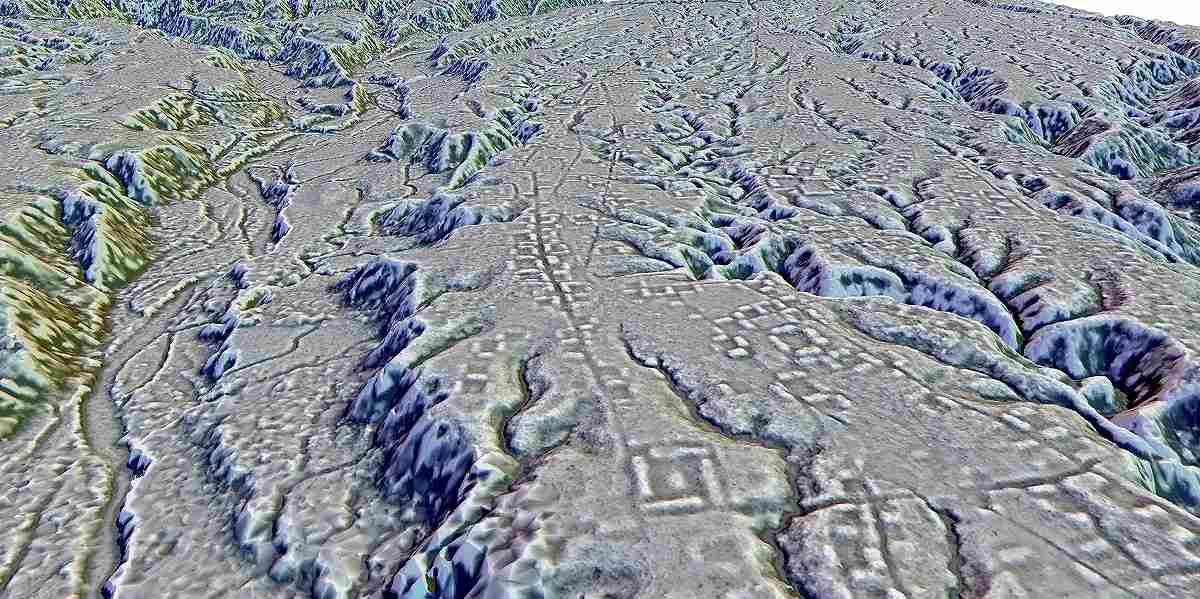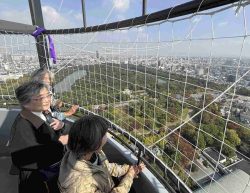A Cluster of Lost Cities in Ecuadorian Amazon that Lasted 1,000 Years Has Been Mapped

This LIDAR image provided by researchers in January 2024 shows complexes of rectangular platforms arranged around low squares and distributed along wide dug streets at the Kunguints site, Upano Valley in Ecuador.
16:56 JST, January 12, 2024
WASHINGTON (AP) — Archeologists have uncovered a cluster of lost cities in the Amazon rainforest that was home to at least 10,000 farmers around 2,000 years ago.
A series of earthen mounds and buried roads in Ecuador was first noticed more than two decades ago by archaeologist Stéphen Rostain. But at the time, “I wasn’t sure how it all fit together,” said Rostain, one of the researchers who reported on the finding Thursday in the journal Science.
Recent mapping by laser-sensor technology revealed those sites to be part of a dense network of settlements and connecting roadways, tucked into the forested foothills of the Andes, that lasted about 1,000 years.
“It was a lost valley of cities,” said Rostain, who directs investigations at France’s National Center for Scientific Research. “It’s incredible.”
The settlements were occupied by the Upano people between around 500 B.C. and 300 to 600 A.D. — a period roughly contemporaneous with the Roman Empire in Europe, the researchers found.
Residential and ceremonial buildings erected on more than 6,000 earthen mounds were surrounded by agricultural fields with drainage canals. The largest roads were 33 feet (10 meters) wide and stretched for 6 to 12 miles (10 to 20 kilometers).
While it’s difficult to estimate populations, the site was home to at least 10,000 inhabitants — and perhaps as many as 15,000 or 30,000 at its peak, said archaeologist Antoine Dorison, a study co-author at the same French institute. That’s comparable to the estimated population of Roman-era London, then Britain’s largest city.
“This shows a very dense occupation and an extremely complicated society,” said University of Florida archeologist Michael Heckenberger, who was not involved in the study. “For the region, it’s really in a class of its own in terms of how early it is.”
José Iriarte, a University of Exeter archaeologist, said it would have required an elaborate system of organized labor to build the roads and thousands of earthen mounds.
“The Incas and Mayans built with stone, but people in Amazonia didn’t usually have stone available to build — they built with mud. It’s still an immense amount of labor,” said Iriarte, who had no role in the research.
The Amazon is often thought of as a “pristine wilderness with only small groups of people. But recent discoveries have shown us how much more complex the past really is,” he said.
Scientists have recently also found evidence of intricate rainforest societies that predated European contact elsewhere in the Amazon, including in Bolivia and in Brazil.
“There’s always been an incredible diversity of people and settlements in the Amazon, not only one way to live,” said Rostain. “We’re just learning more about them.”
"News Services" POPULAR ARTICLE
-

American Playwright Jeremy O. Harris Arrested in Japan on Alleged Drug Smuggling
-

Japan’s Nikkei Stock Average as JGB Yields, Yen Rise on Rate-Hike Bets
-

Japan’s Nikkei Stock Average Licks Wounds after Selloff Sparked by BOJ Hike Bets (UPDATE 1)
-

Japanese Bond Yields Zoom, Stocks Slide as Rate Hike Looms
-

Japan’s Nikkei Stock Average Buoyed by Stable Yen; SoftBank’s Slide Caps Gains (UPDATE 1)
JN ACCESS RANKING
-

Keidanren Chairman Yoshinobu Tsutsui Visits Kashiwazaki-Kariwa Nuclear Power Plant; Inspects New Emergency Safety System
-

Imports of Rare Earths from China Facing Delays, May Be Caused by Deterioration of Japan-China Relations
-

University of Tokyo Professor Discusses Japanese Economic Security in Interview Ahead of Forum
-

Japan Pulls out of Vietnam Nuclear Project, Complicating Hanoi’s Power Plans
-

Govt Aims to Expand NISA Program Lineup, Abolish Age Restriction



























